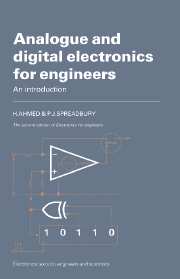Book contents
- Frontmatter
- Contents
- Preface to the second edition
- Preface to the first edition
- 1 Principles of amplifiers
- 2 The p–n junction and the field-effect transistor
- 3 The bipolar transistor
- 4 Operational amplifiers and linear integrated circuits
- 5 Negative feedback
- 6 Positive feedback and oscillators
- 7 Digital fundamentals
- 8 Digital circuits and applications
- Appendix A A list of useful textbooks
- Appendix B Device data and characteristics
- Answers to problems
- Index
2 - The p–n junction and the field-effect transistor
Published online by Cambridge University Press: 05 June 2012
- Frontmatter
- Contents
- Preface to the second edition
- Preface to the first edition
- 1 Principles of amplifiers
- 2 The p–n junction and the field-effect transistor
- 3 The bipolar transistor
- 4 Operational amplifiers and linear integrated circuits
- 5 Negative feedback
- 6 Positive feedback and oscillators
- 7 Digital fundamentals
- 8 Digital circuits and applications
- Appendix A A list of useful textbooks
- Appendix B Device data and characteristics
- Answers to problems
- Index
Summary
Introduction
The p–n junction is used a great deal in semiconductor circuitry, both on its own and as an integral part of many amplifying semiconductor devices. As a circuit element its most frequent use is as a diode or rectifying component. It is also used in the form of a Zener diode to act as a voltage reference and its non-linear characteristic is utilised in detector circuits. In integrated circuits, p–n junctions are found as diodes, resistors and capacitors! Both field-effect transistors and bipolar transistors contain one or more p–n junctions. We therefore begin this chapter with a discussion of the p–n junction although our basic intention in this book is to restrict ourselves to amplifying devices and their circuits. The reader who is not familiar with terms such as p-type and n-type material, doping, impurities, etc., which are used in discussing semiconductor devices can find a brief account in the books listed in appendix A.
The operation of the field-effect transistor, its characteristics and its use as a voltage amplifier are described. Representation of the transistor by an equivalent circuit of passive components and generators leads to a method of analysis for gain, input and output impedance. The metal-oxide semiconductor transistor is also described in this chapter. Finally, a numerical example is solved to illustrate circuit design and analytic techniques.
The sections on field-effect transistors may be read before or after the next chapter on bipolar transistors depending on the wishes or needs of the reader.
- Type
- Chapter
- Information
- Analogue and Digital Electronics for EngineersAn Introduction, pp. 36 - 75Publisher: Cambridge University PressPrint publication year: 1984

